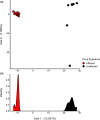Whole genome resequencing reveals signatures of rapid selection in a virus-affected commercial fishery
- PMID: 35555938
- PMCID: PMC9327721
- DOI: 10.1111/mec.16499
Whole genome resequencing reveals signatures of rapid selection in a virus-affected commercial fishery
Abstract
Infectious diseases are recognized as one of the greatest global threats to biodiversity and ecosystem functioning. Consequently, there is a growing urgency to understand the speed at which adaptive phenotypes can evolve and spread in natural populations to inform future management. Here we provide evidence of rapid genomic changes in wild Australian blacklip abalone (Haliotis rubra) following a major population crash associated with an infectious disease. Genome scans on H. rubra were performed using pooled whole genome resequencing data from commercial fishing stocks varying in historical exposure to haliotid herpesvirus-1 (HaHV-1). Approximately 25,000 single nucleotide polymorphism loci associated with virus exposure were identified, many of which mapped to genes known to contribute to HaHV-1 immunity in the New Zealand pāua (Haliotis iris) and herpesvirus response pathways in haliotids and other animal systems. These findings indicate genetic changes across a single generation in H. rubra fishing stocks decimated by HaHV-1, with stock recovery potentially determined by rapid evolutionary changes leading to virus resistance. This is a novel example of apparently rapid adaptation in natural populations of a nonmodel marine organism, highlighting the pace at which selection can potentially act to counter disease in wildlife communities.
Keywords: blacklip abalone; genetic adaptation; haliotid herpesvirus-1; infectious diseases; southeastern Australia; whole genome resequencing.
© 2022 The Authors. Molecular Ecology published by John Wiley & Sons Ltd.
Conflict of interest statement
The authors declare no conflict of interest.
Figures




Similar articles
-
Innate resistance of New Zealand paua to abalone viral ganglioneuritis.J Invertebr Pathol. 2017 Jun;146:31-35. doi: 10.1016/j.jip.2017.04.005. Epub 2017 Apr 18. J Invertebr Pathol. 2017. PMID: 28431886
-
A first annotated genome sequence for Haliotis midae with genomic insights into abalone evolution and traits of economic importance.Mar Genomics. 2023 Aug;70:101044. doi: 10.1016/j.margen.2023.101044. Epub 2023 May 15. Mar Genomics. 2023. PMID: 37196472
-
Susceptibility of two abalone species, Haliotis diversicolor supertexta and Haliotis discus hannai, to Haliotid herpesvirus 1 infection.J Invertebr Pathol. 2019 Jan;160:26-32. doi: 10.1016/j.jip.2018.11.008. Epub 2018 Dec 1. J Invertebr Pathol. 2019. PMID: 30513284
-
Abalone Viral Ganglioneuritis.Pathogens. 2020 Sep 1;9(9):720. doi: 10.3390/pathogens9090720. Pathogens. 2020. PMID: 32882932 Free PMC article. Review.
-
How Fish Population Genomics Can Promote Sustainable Fisheries: A Road Map.Annu Rev Anim Biosci. 2024 Feb 15;12:1-20. doi: 10.1146/annurev-animal-021122-102933. Epub 2023 Oct 31. Annu Rev Anim Biosci. 2024. PMID: 37906837 Review.
Cited by
-
Evidence of Fine-Scale Genetic Structure in Tiger Sharks (Galeocerdo cuvier) Highlights the Importance of Stratified Sampling Regimes.Evol Appl. 2025 Jun 8;18(6):e70117. doi: 10.1111/eva.70117. eCollection 2025 Jun. Evol Appl. 2025. PMID: 40495934 Free PMC article.
References
-
- Agriculture Victoria . (2021) Abalone Disease. Accessed July 2021. https://agriculture.vic.gov.au/biosecurity/animal‐diseases/abalone‐disease
-
- Andrew, N. (1999). Under southern seas: The ecology of Australia's rocky reefs. UNSW Press.
-
- Badariotti, F. , Lelong, C. , Dubos, M. P. , & Favrel, P. (2007). Characterization of chitinase‐like proteins (Cg‐Clp1 and Cg‐Clp2) involved in immune defence of the mollusc Crassostrea gigas. FEBS Journal, 274, 3646–3654. - PubMed
-
- Bai, C.‐M. , Li, Y.‐N. , Chang, P.‐H. , Jiang, J.‐Z. , Xin, L.‐S. , Li, C. , Wang, J.‐Y. , & Wang, C.‐M. (2019). Susceptibility of two abalone species, Haliotis diversicolor supertexta and Haliotis discus hannai, to Haliotid herpesvirus 1 infection. Journal of Invertebrate Patholology, 160, 26–32. 10.1016/j.jip.2018.11.008 - DOI - PubMed
Publication types
MeSH terms
Associated data
LinkOut - more resources
Full Text Sources

